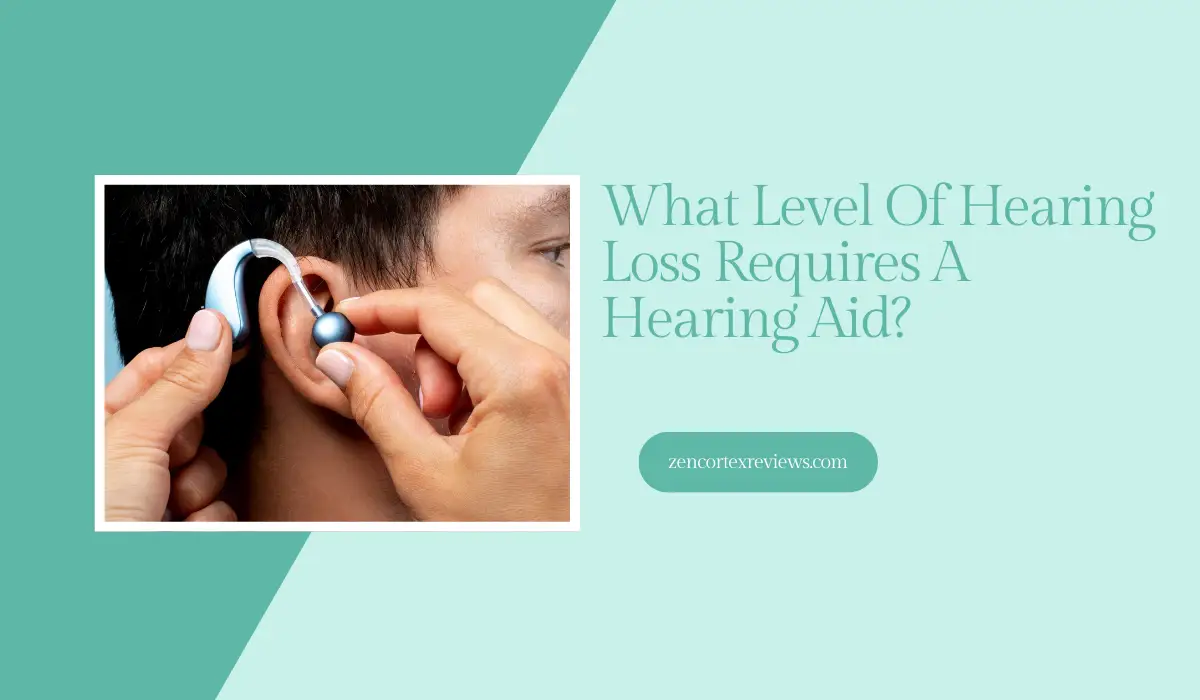What Level Of Hearing Loss Requires A Hearing Aid? Different Types And Severities!
Uncover when a hearing aid is necessary for various levels of hearing loss. From mild to profound, learn about the different types and severities of hearing impairment and when intervention is recommended. Explore the factors influencing the need for a hearing aid and make informed decisions about your auditory health. Dive into our comprehensive guide to understand “what level of hearing loss requires a hearing aid” and improve your quality of life.

Disclaimer: Our recommendations are sincere, driven by the products’ benefits. When you buy through our links, we may earn a commission, backing our testing and development at no extra cost to you.
Hearing loss can have a significant impact on our daily lives, affecting our ability to communicate effectively and engage in social interactions. As hearing loss progresses, it may become necessary to consider using a hearing aid to improve your quality of life. But how do you know when it’s time to seek professional help and explore hearing aid options? In this article, we’ll explore the different levels of hearing loss and the types that may require the use of a hearing aid.
Do I Need A Hearing Aid For Mild Hearing Loss?

If you have mild hearing loss, you may not necessarily need a hearing aid immediately. However, it’s important to monitor the condition and seek professional advice, as even mild hearing loss can affect your ability to communicate effectively in certain situations, such as in noisy environments or when listening to soft sounds.
Levels Of Hearing Loss Chart
Hearing loss is typically categorized into different levels based on the degree of impairment. The following chart provides an overview of the different levels of hearing loss:
| Normal Hearing | 10 to 25 dB |
| Mild Hearing Loss | 26 to 40 dB |
| Moderate Hearing Loss | 41 to 70 dB |
| Severe Hearing Loss | 71 to 90 dB |
| Profound Hearing Loss | 91+ dB |
The 5 Levels Of Hearing Loss
Hearing loss is typically categorized into different degrees based on the level of impairment:
↪️ Normal Hearing: This is the ability to hear sounds within the typical range of human hearing.
↪️ Mild Hearing Loss: In this stage, you may have difficulty hearing soft sounds or following conversations in noisy environments. Hearing aids may not be necessary, but communication strategies and assistive listening devices can be helpful.
↪️ Moderate Hearing Loss: At this level, you may struggle to hear conversational speech and experience difficulties in many social situations. Hearing aids are often recommended to improve your ability to communicate and participate in daily activities.
↪️ Severe Hearing Loss: With severe hearing loss, you may only be able to hear very loud sounds or those close to your ear. Hearing aids are essential for improving your quality of life and enabling effective communication.
↪️ Profound Hearing Loss: At this stage, you may be unable to hear most sounds, even those close to your ear. In addition to hearing aids, you may need to explore other communication methods, such as lip-reading or sign language.
What Level Of Hearing Loss Requires A Hearing Aid?
The decision to use a hearing aid depends on the type and severity of your hearing loss, as well as your lifestyle and communication needs. Generally, hearing aids are recommended when you experience a moderate to severe degree of hearing loss, which can significantly impact your ability to communicate effectively.
Hearing Aids For Mild To Moderate Hearing Loss In Adults
For adults with mild to moderate hearing loss, hearing aids can be beneficial in improving communication and overall quality of life. Hearing aids can amplify sounds and help individuals better understand speech, especially in noisy environments or during group conversations.
Mild To Moderate Hearing Loss Audiogram
An audiogram is a graph that displays the results of a hearing test. It shows the degree of hearing loss at different frequencies (pitches) for each ear. For individuals with mild to moderate hearing loss, the audiogram may show a sloping or gradual hearing loss pattern, indicating difficulty hearing certain frequencies.
How Is Hearing Loss Severity Determined?
Hearing loss severity is typically determined by an audiological evaluation performed by a licensed audiologist or hearing care professional. This evaluation involves a series of tests designed to measure your ability to hear different frequencies and volumes of sound.
Tests Used To Assess Hearing Loss
The most common tests used to assess hearing loss include:
↪️ Pure-tone audiometry: This test measures your ability to hear different frequencies (pitches) and intensities (volumes) of sound.
↪️ Speech audiometry: This test evaluates your ability to understand and recognize spoken words and phrases at different volumes.
↪️ Tympanometry: This test measures the function of your middle ear and the mobility of your eardrum.
↪️ Auditory brainstem response (ABR): This test measures the brain’s response to sound stimuli, which can help identify issues with the auditory nerve or brainstem.
What Steps Can I Take To Preserve My Hearing Health?
While hearing loss can be a natural part of aging, there are several steps you can take to protect your hearing and prevent further deterioration:
↪️ Avoid exposure to excessive noise: Loud noises, such as those from machinery, concerts, or personal audio devices, can damage your hearing over time. Use hearing protection, such as earplugs or noise-canceling headphones, when exposed to loud sounds.
↪️ Manage underlying medical conditions: Certain medical conditions, such as diabetes, cardiovascular disease, or thyroid disorders, can contribute to hearing loss. Work with your healthcare provider to manage these conditions effectively.
↪️ Quit smoking: Smoking has been linked to an increased risk of hearing loss, as it can damage the delicate structures within the ear and impair blood flow.
↪️ Practice good ear hygiene: Avoid inserting objects into your ears, as this can lead to injury or damage to the eardrum. Use over-the-counter ear drops or seek professional help for safe ear cleaning.
↪️ Schedule regular hearing check-ups: Regular hearing evaluations can help detect hearing loss early and ensure timely intervention and treatment.
Related: How To Improve Hearing Without Hearing Aids: 7 Natural Strategies That Work
Sum Up
Hearing loss can range from mild to profound, and the decision to use a hearing aid depends on the severity of your condition and its impact on your daily life. If you experience any signs of hearing difficulty, it’s essential to seek professional evaluation and guidance. By understanding the different levels of hearing loss and taking proactive steps to preserve your hearing health, you can maintain optimal communication abilities and enjoy a better quality of life.
Lindsay Martinez
Lindsay Martinez, Au.D., is a licensed audiologist with over 10 years of experience in the field of hearing healthcare. She earned her Doctor of Audiology degree from the University of California, Los Angeles, and currently practices at Martinez Hearing Clinic, a leading audiology practice in the San Francisco Bay Area. As an expert in diagnosing and treating a wide range of hearing disorders, Dr. Martinez specializes in fitting advanced hearing aids and assistive listening devices. She is a fellow of the American Academy of Audiology and has published numerous peer-reviewed articles on topics such as noise-induced hearing loss and the latest innovations in hearing technology. Passionate about patient education, Dr. Martinez is committed to helping her patients improve their hearing and overall quality of life.
